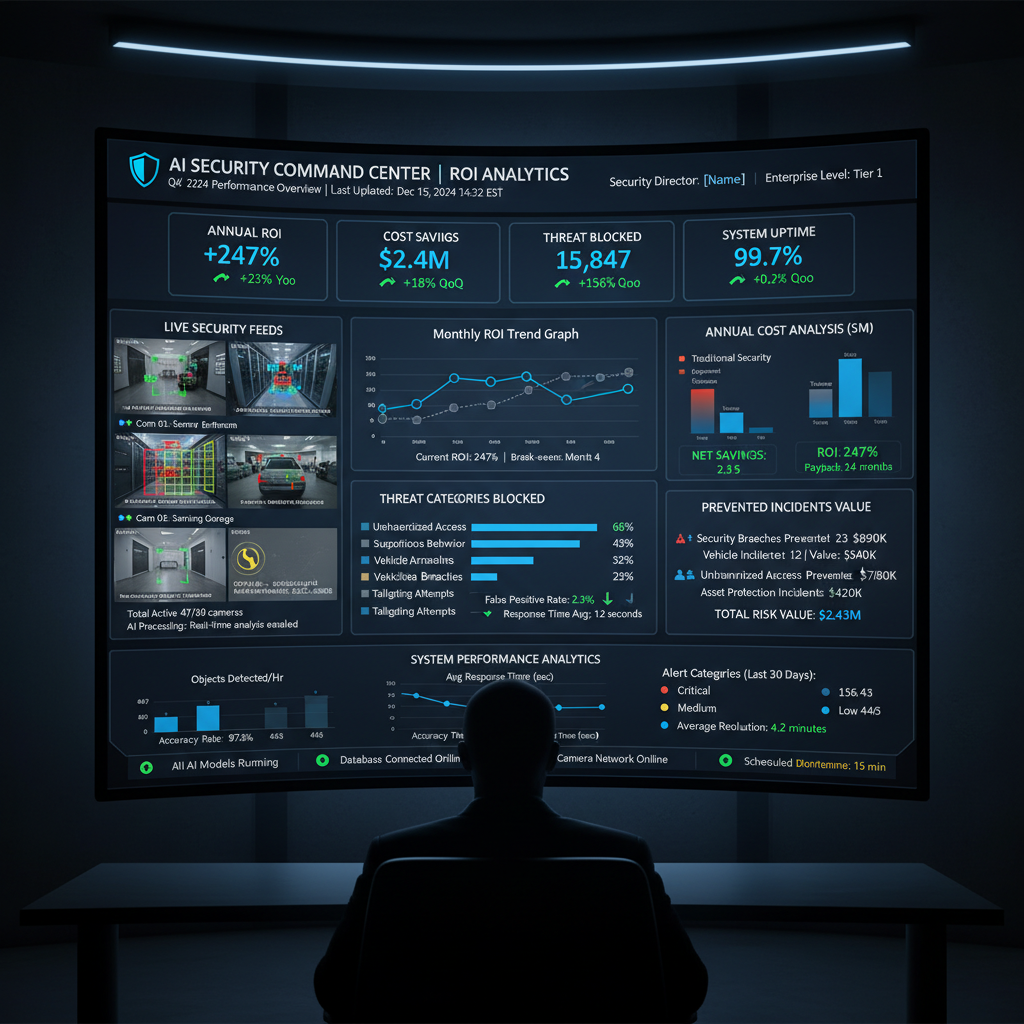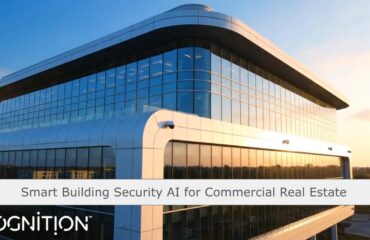
Executive Summary
The physical security landscape is experiencing a paradigm shift. Traditional reactive security models—where human operators monitor dozens of camera feeds and respond to incidents after they occur—are rapidly becoming obsolete. Today’s security teams face mounting pressure to do more with less: reduce security incidents, cut operational costs, and demonstrate measurable ROI on security investments.
Artificial Intelligence (AI) has emerged as the game-changing solution that transforms security from a cost center into a strategic business enabler. Organizations implementing AI security systems report average incident reduction rates of 35%, operational cost savings of 25-40%, and response time improvements of up to 80%.
This comprehensive guide provides security directors with the strategic framework needed to evaluate, implement, and maximize the value of physical security AI initiatives. Whether you’re managing a corporate campus, retail chain, manufacturing facility, school, or critical infrastructure, understanding how to leverage intelligent video analytics, AI threat detection, and smart security solutions is no longer optional—it’s essential for maintaining competitive security operations.
What is Physical Security AI and How It Transforms Operations
Physical Security AI represents a fundamental evolution from traditional surveillance systems to intelligent, autonomous security platforms. Rather than simply recording events for post-incident analysis, AI-powered systems actively monitor, analyze, and respond to potential threats in real-time.
The Technology Foundation
At its core, physical security AI combines three critical technologies:
Computer Vision: Advanced algorithms that can “see” and interpret visual information from cameras, identifying objects, people, behaviors, and anomalies with human-level or superior accuracy.
Machine Learning: Systems that continuously improve their detection capabilities by learning from historical data, environmental patterns, and operational feedback.
Edge Computing: Processing power deployed directly at camera and sensor locations, enabling instant analysis without network latency delays.
Transformational Impact on Security Operations
The operational transformation is profound. Consider a typical security operations center (SOC) managing 200 cameras across multiple locations. Traditional approaches require multiple operators per shift, with human attention spans limiting effective monitoring to 10-15 cameras maximum per operator. Alert fatigue and false alarms consume significant amounts of operator time.
AI transforms this model by:
- Automating Routine Monitoring: AI systems can simultaneously analyze unlimited camera feeds 24/7 without fatigue or distraction
- Intelligent Alert Prioritization: Only genuine threats trigger human intervention, reducing false alarms by up to 90%
- Predictive Capabilities: Pattern recognition identifies potential security risks before incidents escalate
- Integrated Response: Automated workflows trigger appropriate responses based on threat severity and type
Leading organizations report operational improvements including:
- 50% reduction in required monitoring staff
- 90% decrease in false alarm rates
- Real-time, proactive threat detection
- Significant improvement in incident prevention and deterrence
Key AI Security Systems Capabilities Including Intelligent Video Analytics
Modern AI security systems deliver sophisticated capabilities that extend far beyond traditional video surveillance. Understanding these core capabilities helps security directors identify the highest-impact applications for their specific environments.
Intelligent Video Analytics: The Foundation Layer
Intelligent video analytics serves as the primary sensor layer for AI security systems. Today’s advanced analytics platforms provide:
Object Detection and Classification
- Real-time identification of people, vehicles, packages, and weapons
- Accurate classification even in challenging lighting conditions
- Integration with existing camera infrastructure (no hardware replacement required)
Behavioral Analysis
- Detection of suspicious behaviors: loitering, tailgating, aggressive movements
- Recognition of normal vs. abnormal activity patterns
- Crowd behavior analysis for public safety applications
Perimeter Protection
- Virtual fence creation with customizable detection zones
- Direction-aware intrusion detection
- Integration with access control systems for comprehensive coverage
Advanced AI Threat Detection Capabilities
Beyond basic analytics, enterprise AI security systems deliver sophisticated threat detection:
Weapon Detection
Modern AI systems can identify firearms, knives, and improvised weapons with 90%+ accuracy rates, triggering immediate lockdown procedures and law enforcement notification within seconds of detection.
Violence and Aggression Recognition
Behavioral AI algorithms detect physical altercations, aggressive postures, and crowd disturbances before situations escalate, enabling proactive intervention.
Unauthorized Access Detection
Integration with access control systems enables AI to identify individuals in restricted areas, vehicles in prohibited zones, and attempts to bypass security checkpoints.
Anomaly Detection
Machine learning algorithms establish baseline “normal” patterns for each monitored area, automatically flagging deviations that could indicate security risks.
Smart Security Solutions Integration
The most powerful AI security implementations integrate multiple systems into unified platforms:
Access Control Integration
- Facial recognition for touchless entry
- Visitor management automation
- Real-time occupancy tracking and compliance monitoring
Emergency Response Coordination
- Automated notification systems for first responders
- Integration with fire safety, medical alert, and evacuation systems
- Mass notification capabilities for crisis communication
Business Intelligence Integration
- Operational metrics dashboards for security performance tracking
- Incident trend analysis and reporting
- Integration with HR systems for employee safety monitoring
Business Case and ROI Considerations for AI Threat Detection
Security directors must build compelling business cases that demonstrate clear ROI for AI investments. The financial benefits typically fall into four categories: cost reduction, risk mitigation, operational efficiency, and business enablement.
Direct Cost Reduction Opportunities
Security Staffing Optimization
Traditional security operations require 24/7 human monitoring. AI systems can reduce required staffing by up to 50% while improving detection accuracy. For a mid-size facility spending $500,000 annually on security personnel, AI implementation can deliver $200,000-300,000 in annual savings.
False Alarm Reduction
False alarms cost organizations an average of $1,500-3,000 per incident when considering staff response time, law enforcement resources, and business disruption. Security teams typically experience dozens or hundred false alarms annually. AI systems reduce false alarms by up to 90%, delivering immediate cost savings of $250,000-1,000,000+ annually.
Insurance Premium Reductions
Leading insurance providers offer 10-15% premium discounts for organizations implementing certified AI security systems. For organizations with $100,000+ annual security insurance costs, this represents $10,000-15,000 in immediate annual savings.
Risk Mitigation Value
Incident Prevention
The average security incident costs organizations $50,000-250,000 when considering property damage, business interruption, legal exposure, and reputation impact. AI systems that prevent just 2-3 major incidents annually can justify investment costs entirely through avoided losses.
Liability Reduction
Comprehensive AI monitoring creates detailed incident documentation, reducing legal exposure and settlement costs. Organizations report up to 50% reductions in security-related liability claims after AI implementation.
Regulatory Compliance
Industries with strict security requirements (healthcare, finance, critical infrastructure) face significant penalties for compliance failures. AI systems provide automated compliance monitoring and documentation, avoiding potential fines ranging from $100,000-10,000,000+ depending on industry and violation severity.
Implementation Investment Framework
Initial Investment Range
- Small facilities (10-25 cameras): $50,000-150,000
- Medium facilities (25-100 cameras): $150,000-500,000
- Large facilities (100+ cameras): $500,000-2,000,000+
Typical ROI Timeline
- Year 1: 25% ROI through immediate operational savings
- Year 2-3: 50% ROI as systems optimize and additional capabilities deploy
- Year 4+: 100%+ ROI through full operational transformation
Financing Options
Many organizations leverage Security-as-a-Service (SECaaS) models that eliminate upfront capital requirements and provide predictable monthly operational expenses ranging from $200-2,000 per camera depending on AI capabilities and service levels.
Implementation Best Practices for Smart Security Solutions
Successful AI security implementations require strategic planning, stakeholder alignment, and phased deployment approaches. Based on analysis of hundreds of enterprise implementations, several critical success factors emerge.
Phase 1: Strategic Assessment and Planning (30-60 days)
Security Risk Assessment
Begin with comprehensive threat modeling specific to your environment. Corporate campuses emphasize access control and workplace violence prevention. Manufacturing facilities prioritize perimeter security and employee safety monitoring. Retail environments focus on theft prevention and customer safety.
Infrastructure Readiness Evaluation
Assess existing camera infrastructure, network capacity, and storage capabilities. Modern AI systems require:
- Minimum 1080p camera resolution (4K preferred for advanced analytics)
- Network bandwidth of 2-5 Mbps per camera for AI processing
- Edge computing capabilities for real-time processing requirements
Stakeholder Alignment
Successful implementations require buy-in from IT, facilities management, legal, and executive leadership. Common concerns include privacy implications, integration complexity, and change management requirements.
Phase 2: Pilot Implementation (60-90 days)
Limited Scope Deployment Start with 5-15 cameras in high-priority areas to demonstrate value and refine configuration. Common pilot locations include main entrances, parking areas, and high-traffic corridors where ROI measurement is straightforward.
Performance Baseline Establishment Document current security metrics including incident response times, false alarm rates, and staffing requirements. These baselines become essential for measuring AI implementation success.
User Training and Change Management Security operators require training on new AI interfaces and alert management workflows. Most organizations report 2-4 weeks for full operator proficiency with properly designed systems.
Phase 3: Full-Scale Deployment (90-180 days)
Systematic Rollout Expand coverage systematically, typically adding 20-50 cameras per month to allow for proper integration testing and operator adjustment. Rush deployments often result in configuration issues and user resistance.
Integration with Existing Systems Connect AI platforms with existing access control, fire safety, and business management systems. Full integration typically requires 30-60 days but delivers the highest operational value.
Continuous Optimization AI systems require ongoing tuning for optimal performance. Plan for quarterly configuration reviews and algorithm updates to maintain peak effectiveness.
Technology Selection Criteria
Cloud vs. Edge Processing
Edge Processing Advantages:
- Sub-second response times for critical threats
- Reduced network bandwidth requirements
- Enhanced privacy and data security
- Continued operation during network outages
Cloud Processing Advantages:
- Lower upfront hardware costs
- Easier software updates and maintenance
- Advanced analytics requiring massive computing power
- Centralized management across multiple locations
Most enterprise implementations use hybrid approaches, with edge processing for real-time alerts and cloud processing for advanced analytics and reporting.
Integration Capabilities
Evaluate vendors based on:
- Open API architecture for third-party integrations
- Support for existing camera brands and models
- Compatibility with current access control and building management systems
- Mobile management capabilities for security teams
- Compliance with industry standards (ONVIF, PSIA)
Vendor Evaluation Framework
Technical Capabilities:
- Accuracy rates for specific use cases (weapon detection, behavioral analysis)
- Processing speed and scalability
- Customization and configuration flexibility
- Update and maintenance requirements
Business Factors:
- Implementation timeline and support quality
- Total cost of ownership over 5-year period
- Financial stability and long-term viability
- Reference customer satisfaction and case studies
Privacy and Compliance Considerations
Data Privacy Requirements
AI security systems process significant personal data, requiring careful attention to privacy regulations:
GDPR Compliance (European Operations):
- Explicit consent for facial recognition systems
- Data minimization and retention policies
- Right to erasure and data portability
- Privacy impact assessments for high-risk processing
State Privacy Laws (US Operations):
- California Consumer Privacy Act (CCPA) requirements
- Illinois Biometric Information Privacy Act (BIPA) compliance
- Varying state requirements for video surveillance and data retention
Industry-Specific Compliance
Healthcare (HIPAA):
- Protected health information safeguards in medical facilities
- Business associate agreements with AI vendors
- Audit logging and access controls
Financial Services:
- SOX compliance for fraud prevention systems
- Anti-money laundering (AML) detection capabilities
- PCI DSS requirements for payment processing areas
Education (FERPA):
- Student privacy protections in educational environments
- Consent requirements for biometric systems
- Data sharing restrictions with third parties
Measuring Success: Key Performance Indicators
Security Effectiveness Metrics
Incident Prevention:
- Number of security incidents prevented through early detection
- Reduction in property damage and theft losses
- Improvement in employee and visitor safety scores
Response Time Improvements:
- Average time from threat detection to security team notification
- Time to implement appropriate response measures
- Coordination effectiveness with law enforcement and emergency services
Operational Efficiency Metrics
Cost Savings:
- Reduction in security staffing requirements
- Decrease in false alarm response costs
- Insurance premium savings and claim reductions
System Performance:
- Detection accuracy rates by threat type
- False positive rates and trend analysis
- System uptime and reliability metrics
Business Impact Metrics
Risk Mitigation:
- Reduction in security-related liability claims
- Improvement in regulatory compliance audit results
- Enhancement of corporate reputation and stakeholder confidence
Operational Benefits:
- Integration with business intelligence systems
- Contribution to overall facility management efficiency
- Support for business continuity planning
Future Trends in Physical Security AI
Emerging Technologies
Advanced Computer Vision:
- 3D object recognition and spatial analysis
- Thermal imaging integration for enhanced detection
- Multi-spectral imaging for challenging environments
Predictive Analytics:
- Behavior pattern analysis for threat prediction
- Integration with external threat intelligence feeds
- Seasonal and temporal pattern recognition
Autonomous Response:
- Automated physical security responses (door locks, barriers)
- Drone integration for perimeter monitoring and response
- Robotic security patrol coordination
Industry Evolution
Standardization Development:
- Industry-wide API standards for system integration
- Certification programs for AI security accuracy
- Privacy-by-design frameworks for compliant deployments
Market Consolidation:
- Platform convergence combining multiple security functions
- Increased focus on total solution providers
- Growth in managed security service offerings
Conclusion: Taking Action on Physical Security AI
The transformation from traditional reactive security to AI-powered proactive security represents one of the most significant operational improvements available to security directors today. Organizations delaying AI implementation face growing competitive disadvantages as security threats evolve and operational cost pressures intensify.
Immediate Next Steps
- Conduct Security Risk Assessment: Identify your highest-priority security challenges and areas where AI can deliver immediate value
- Evaluate Current Infrastructure: Assess your existing camera, network, and storage capabilities for AI readiness
- Build Business Case: Quantify potential ROI using the frameworks provided in this guide
- Engage Stakeholders: Align IT, facilities, legal, and executive leadership on AI security strategy
- Select Pilot Area: Choose 5-15 cameras in high-impact locations for initial implementation
Long-term Strategic Considerations
Physical security AI implementation should align with broader organizational digital transformation initiatives. The most successful deployments integrate with enterprise resource planning, human resources, and business intelligence systems to maximize value across the organization.
Security directors who act now to implement AI security systems position their organizations for sustained competitive advantage through reduced costs, improved risk management, and enhanced operational efficiency. The question is not whether to implement AI security—but how quickly you can realize its transformative benefits for your organization.
The future of physical security is intelligent, proactive, and highly automated. Organizations that embrace this transformation today will lead their industries tomorrow.



